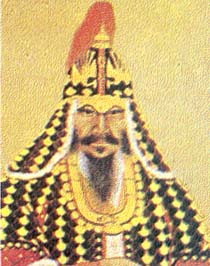This article needs additional citations for verification. (March 2024) |
Gwon Yul | |
|---|---|
 A portrait of Gwon Yul drawn by Jang Woo-sung in 1970 | |
| Born | 28 December 1537 Gyeonggi Province, Joseon |
| Died | 6 July 1599 (aged 61) Goyang, Gyeonggi Province, Joseon |
| Allegiance | Joseon |
| Rank | Dowonsu |
| Battles / wars | Japanese invasions of Korea (1592–98) |
| Spouse(s) | Lady Jo Lady Park |
| Children | Lady Gwon Gwon Ik-kyung (adopted son) |
| Relations | Gwon Cheol (father) |
| Korean name | |
| Hunminjeongeum | 권율 |
| Hanja | 權慄 |
| Revised Romanization | Gwon Yul |
| McCune–Reischauer | Kwŏn Yul |
| Courtesy name | |
| Hunminjeongeum | 언신 |
| Hanja | 彦愼 |
| Revised Romanization | Eonsin |
| McCune–Reischauer | Ŏnsin |
| Posthumous name | |
| Hunminjeongeum | 충장 |
| Hanja | 忠莊 |
| Revised Romanization | Chungjang |
| McCune–Reischauer | Ch'ungjang |
Gwon Yul (Korean: 권율; Hanja: 權慄; 28 December 1537 – 6 July 1599) was a Korean army general and the commander-in-chief (도원수; 導元帥) of the Joseon period, who successfully led the Korean forces against Japan during the Japanese invasions of Korea. He is best known for the Battle of Haengju where he defeated an attacking force of about 30,000 Japanese with 2,800 troops.
After the Japanese invasion of Korea in 1592, Yi Gwang-gwan and Kwokyeong, a Joseon patrol in Jeolla Province, joined the army of some 40,000 people. After that, he was stationed in Namwon, where he collected more than 1,000 volunteer soldiers and was promoted to a small division of Dakage, Kobayakawa, Japan.
In addition, during the Japanese invasion, Dongwangsansan Fortress in Suwon was located, and a strong position was built, but the army was engaged in a war of land and a war of guerrilla fighters. In 1593, he divided his forces and ordered SeonguI, the deputy commander, to take the army to the Gimchusan Mountain, and then cross the Han River with 2,800 soldiers. He was dismissed for summary disposal of fugitives after earning his degree in the field, but was re-appointed as a judge of the Han family and was appointed as a military officer in 1596. When Jeong Yu-jaran broke out in 1597, he was forced to leave Ulsan with the emperor of Ming to block the enemy's advancing north, but suddenly he was ordered to retreat by Yáng Hao as the commander of the Ming Dynasty.
Afterwards, he attempted to attack the Japanese troops stationed in Yegyo Bridge in Suncheon, but failed due to the uncooperative efforts of the Ming Dynasty men who were reluctant to expand the war. He was a general who conducted the military for seven years during the Japanese Invasion of Korea in 1592, and earned a major in history along with korean Admiral Yi Sun-shin of the sea. In 1599, he resigned his office due to old age and returned to his hometown. He was awarded the title of Prime Minister, first rank in 1604 (King Seonjo 37), and was designated as Yeongna County, and was named Chungjangsa.